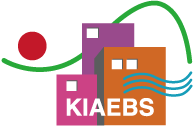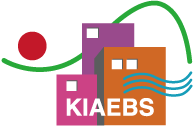서 론
최근 주택 사용자의 라이프 스타일의 변화에 대응하여 다양한 주거환경 관련 기술이 개발되어 공동주택에 접목되고 있다(이재용, 2008). 이에 공동주택의 설비 시스템도 에너지 및 유지관리측면에서 더욱 효율적인 방향으로 개선이 요구되고 있다. 최근 공동주택에 공급되는 지역난방방식은 에너지 절감 및 집중적인 환경관리로 인한 대기환경 개선 등 에너지 절약 및 환경개선 효과를 목적으로 한다(정광섭 외, 2011). 이와 같은 장점을 통해 지역난방 등 중앙 열원을 이용하는 난방시장이 지속 성장하는 추세다. 이에 따라 지역난방 분야에서 더욱 효과적인 에너지 운용을 가능하게 하는 시스템은 국가 에너지의 효율적인 운용을 위해 반드시 필요하다(최인식, 2019). 국내 지역난방 공동주택에서 중앙 열교환을 통해 각 세대에 난방온수 및 급탕을 공급하는 경우, 온수온도 제어 및 공급이 일괄적으로 이루어져, 세대별로 상이한 쾌적 조건을 고려한 급탕온도 설정이 불가하다. 또한 난방온수 공급, 난방온수 환수, 급탕, 환탕 입상관 등 시스템을 설치하기 위해 요구되는 공간과 비용의 규모가 개별열원 급탕방식에 비해 크다는 문제가 제기되어 왔다(안선근 외, 2017). 이러한 측면에서 통합배관시스템은 기존 4배관 방식에 비해 배관의 수와 표면적 등이 줄면서 공사비의 절약과 에너지 절감 등의 장점이 있지만, 세대유닛 사용으로 인하여 관리 항목이 늘어남에 따라 효율적이고 합리적인 통합배관시스템의 관리가 필요하게 되었다(정광섭 외, 2011). 이에 본 연구의 목적은 사례 및 법규 조사를 통하여 난방, 급탕, 수도 설비의 통합 및 개발을 위한 기술적 가능성을 검토하고, 공동주택 세대용 지역난방 열교환 유닛(Heat Interface Unit; HIU)의 개발 방안을 도출하는 것이다.
연구방법 및 범위
공동주택 세대 열교환 유닛의 통합 방향을 도출하기 위하여 관련기준 및 국내 공동주택의 설비현황 조사와 해외의 유사사례 조사를 실시하였다. 첫째, 관련기준의 종류는 법령, 시행령, 시행규칙, 고시, 기타 지침 및 기준에 걸쳐 수도계량기, 난방계량기, 가스계량기, 전력량계, 온수분배기 항목을 규정하고 있는 현황에 대하여 조사한 후 이에 대한 시사점으로 각 계량기를 추후 HIU에 통합할 경우 고려해야 할 사항을 도출하였다. 둘째, 공동주택의 설비현황을 살펴보기 위하여 1999년도부터 2018년 기준으로 최근 20년 사이 준공된 20개 건물의 기계설비 설계도면을 선정하여 조사하였다. 이를 통하여 급수, 급탕, 난방 방식 및 수도계량기, 난방계량기, 가스계량기, 온수분배기의 위치 및 공급방식을 분석하였다. 셋째, 해외의 관련기술 파악을 위하여 유럽 2개 업체의 세대급탕열교환기 사례를 조사하였다. 위의 세 가지 조사방법을 통하여 현행 설비 시스템 설계 추세를 파악하고 이를 대입하여 HIU의 통합 개발 방향을 도출하였다. 연구의 흐름도는 Figure 1과 같다.
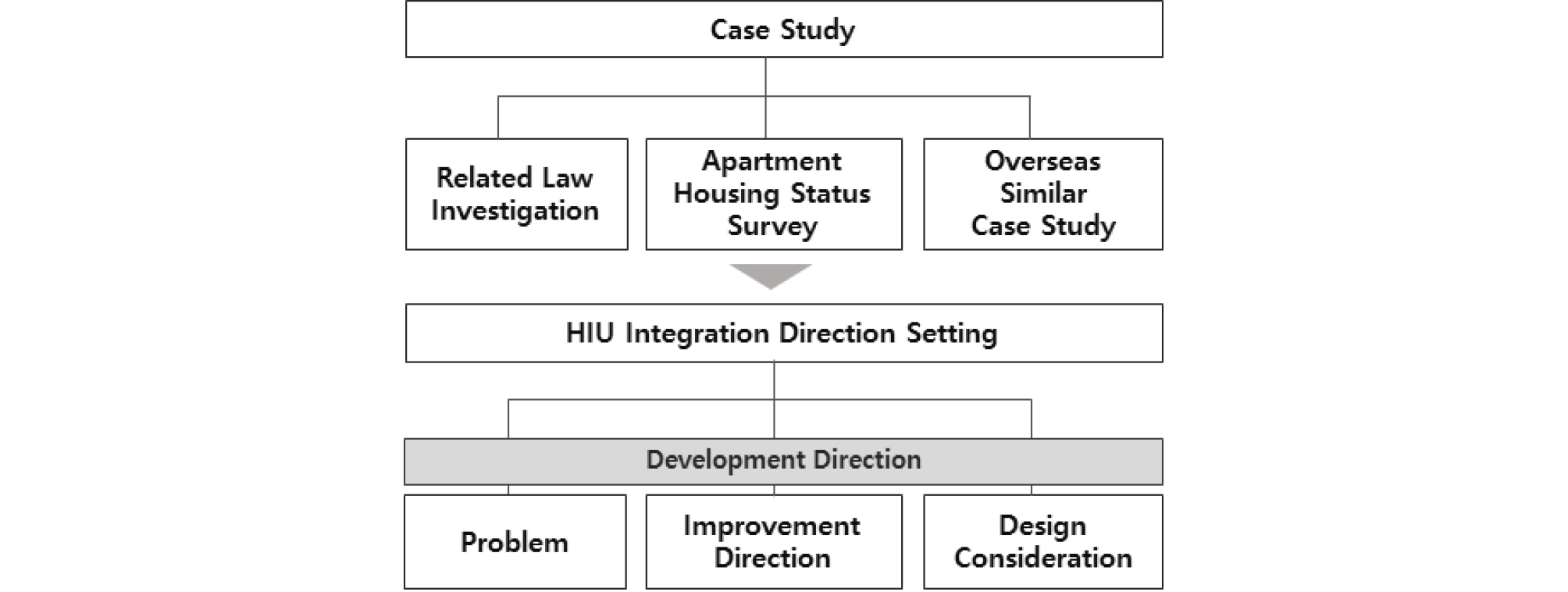
Figure 1.
Research flow chart
스마트 에너지 HIU (Heat Interface Unit) 개념
스마트 에너지 HIU이란, 유럽에서 지역난방 직접 열교환 방식에 사용되고 있는 HIU (Heat Interface Unit)의 개념을 포함하며 저온(60°C 이하) 온수를 공급받아 난방 및 온수를 세대 내에 공급하고 부문별 계량데이터를 통합관제센터로 전송하는 역할을 수행하는 장치이다. 이는 한국건설기술연구원의 “양방향 스마트 제로에너지시티(Smart Zero Energy City) 통합 네트워크 기술 개발” 연구의 일환으로 4세대 지역난방방식으로 인하여 그 필요성이 대두되었다(김용기 외, 2019)(Figure 2 참조). 스마트 에너지 HIU의 열교환방식은 지역열원과 시상수의 판형열교환기를 통한 간접방식이며, 가열된 급수를 따로 저장하지 않으므로 레지오넬라 등의 세균에 대한 오염도가 낮으며, HIU 내의 환수되는 배관에는 자동약품주입기 등을 설치함으로써 세균에 대한 안전성의 확보가 가능할 것으로 판단된다. 한편, 세균에 대한 오염 방지를 위하여 저온 지역열원의 공급수 온도를 60℃ 전후로 유지할 필요가 있다.
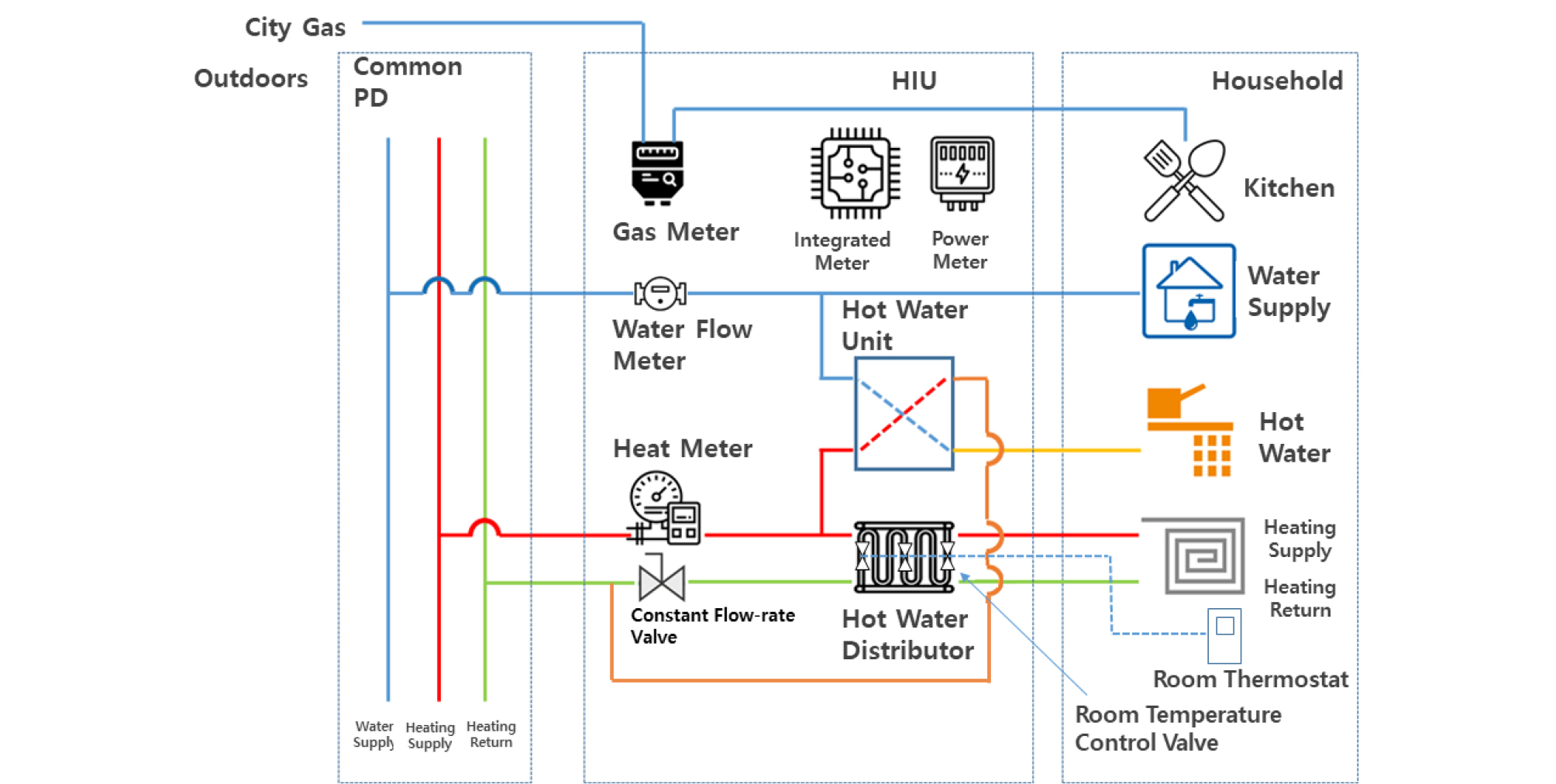
Figure 2.
Conceptual diagram of a HIU (Heat Interface Unit)
스마트 에너지 HIU의 주요 구성품은 판형열교환기, 온수분배기, 유량제어밸브, 온도조절기, 난방, 온수, 수도, 전력량 통합계량기, 게이트웨이, 단열유닛 등이다. 설치 위치는 공동주택의 경우 세대 공용부에, 단독주택은 수도계량기 주위의 외벽에 수납된다. 또한, 스마트 에너지 HIU에서 생산되는 전력, 난방, 온수, 수도소비량 등의 정보는 실시간으로 ZEC (Zero Energy City) 통합관제센터에 전송되어 운영프로그램을 통하여 분석된다. 이는 사용자의 스마트폰 등으로 전송되어 에너지 사용량 및 요금정보 등을 손쉽게 파악할 수 있다(강은철, 2020).
스마트 에너지 HIU 개발방향 설정을 위한 사례조사
설비 계량기별 설치 관련 법규 조사
스마트 에너지 HIU의 통합 및 위치 재조정 등의 가능성을 검토하기 위하여 각 설비 계량기별 설치 관련 기준의 조사가 필요하였다. 이를 위하여 수도계량기, 난방계량기(적산열량계), 가스계량기, 전력량계, 온수분배기의 법적 기준을 조사하였다(성순경 외, 2008). 법적 기준의 범위는 법령, 시행령, 시행규칙, 고시와 더불어 매뉴얼, 시방서, 설계지침 등을 포함하였다. 관련 내용은 각 설비의 설치장소 기준 및 기준, 권장사항 등으로 구성되어 있다(Table 1 참조).
Table 1.
Research on Laws related to smart energy HIUs
|
Category
|
Law/Standard
|
Contents
|
System
|
|
Water
Meter
|
⦁Regulations on Housing Construction Standards 43
|
⦁Water supply & drainage facilities
|
Statute
|
|
⦁Rules for Building Facility Standards Attached Table 3-2
|
⦁Water meter protection box installation standard
|
Statute
|
|
⦁Building Maintenance Inspection Manual
|
Etc
|
|
⦁Waterworks Facility Standard
|
⦁Water meter
|
Etc
|
|
Heating
Meter
|
⦁Regulations on Housing Construction Standards 37
|
⦁Heating equipment
|
Statute
|
|
⦁Criteria for Installation of Heating Meters for Apartments with Centralized Heating 2
|
⦁Installation construction
|
Notification
|
|
Gas
Meter
|
⦁City Gas Business Act Enforcement Rules 5
|
⦁Transitional measures regarding the installation location of gas meters
|
Enforcement Regulation
|
|
Watt-
hour
Meter
|
⦁Enforcement Decree of the Electricity Business Act 43
|
⦁Establishment of technical standards
|
Enforcement Decree
|
|
⦁Electricity Meter Technical Standard
|
⦁Structure requirements
|
Notification
|
|
⦁Judgment Criteria for Electrical Equipment Technical Standards 171
|
⦁Facilities such as low pressure distribution boards installed indoors
|
Etc
|
|
Hot
Water
Distributer
|
⦁Criteria for Installation of Heating Meters for Apartments with Centralized Heating 2
|
⦁Installation construction
|
Notification
|
|
⦁National Construction Standard Center Standard Specification Piping Equipment Construction
|
⦁Installation location of hot water distributors & control valves
|
Etc
|
|
⦁LH, SH Mechanical Equipment Design
|
⦁Installation Location of hot water distributor
|
Etc
|
수도계량기는 ‘건축물 유지관리점검 매뉴얼’에 의하여 공동주택 세대마다 2개소 이상의 급수전을 설치하도록 되어 있으며, ‘건축물의 설비기준 등에 관한 규칙’에 의하여 계량기보호함의 설치위치 및 단열, 보온, 밀봉 방식에 대하여 규정하고 있다. 또한 상수도시설기준에 의하여 수도계량기의 설치장소 선정(지상 혹은 지하) 및 계량기 전후의 직관부 거리 확보 등 구체적인 설치방법을 명시하고 있다. 난방계량기는 ‘주택건설기준등에 관한 규정’에 의하여 공동주택의 각 세대 당 난방열량 계량기와 난방온도 조절장치를 각각 설치하도로 되어 있으며, ‘중앙 집중 난방방식의 공동주택에 대한 난방계량기 등의 설치기준’에 의하여 난방계량기 및 온도조절기 설치 시 입주자 및 관리자의 확인이 가능하도록 설치하며, 유지보수가 용이하도록 각 세대의 전용부분 밖에 설치하도록 규정하고 있다(허헌주, 2012).
가스계량기는 ‘도시가스사업법 시행규칙’에 의하여 화기로부터의 유지거리(2 m 이상) 및 교량기의 교체 및 유지관리가 용이한 곳, 환기 여부, 설치 금지 장소 등에 대하여 언급하고 있다. 또한 적정 설치높이 및 전기계량기 등과의 간격 유지(60 cm 이상) 등에 대하여 규정하고 있다. 전력량계는 ‘전기사업법 시행령’에 의하여 다른 전기설비나 사용자에게 손상을 주지 않는 범위 내에서 설치하도록 되어있으며, ‘전기설비기술기준의 판단기준’에 의하여 옥내 설치 시 점검·보수 용이 및 내연성, 외부로부터의 충격 등을 고려하여 안전하게 설계하도록 규정하고 있다. 온수분배기는 ‘국가건설기준센터 표준시방서 배관설비공사’에 의하여 조작·점검·보수가 쉬운 장소에 설치하도록 되어 있다. 구체적으로 LH 의‘ 기계설비 설계지침’에서는 창고, 반침내(붙박이장) 또는 싱크대 하부에 설치하도록 권장하고 있으며, SH에서는 시공, 관리가 용이하고 소음발생이 적은 장소로 권장하고 있다. 수도, 전기, 가스, 열량 등 법정 계량기의 배치의 적절성 검토 및 HIU에 통합방향을 설정하기 위하여 국가법령, 정부고시 및 지침의 반영이 필요하다. 이를 위한 법규 및 기준의 조사결과는 Table 2와 같다.
Table 2.
Related laws and regulations
|
Category
|
Installation Location
|
Installation Standard
|
|
Water
Meter
|
⦁When installing inside the apartment wall, install it in a protective box such as concrete or synthetic resin.
|
⦁Securing the distance of the intuition before and after the meter (3 to 3.5 times the diameter)
|
|
Heating
Meter
|
⦁Outside the dedicated part of each period
|
⦁Proper insulation to prevent freezing
|
|
Gas
Meter
|
⦁Easy to replace, maintain and ventilate
⦁Installation of user residence is prohibited
|
⦁Keep a distance of more than 2 m from fire
⦁Install height from 1.6 m to 2 m from the floor
⦁Keep gas meter and electricity meter at least 60 cm away
|
Watt-
hour
Meter
|
⦁Installation in a place that is easy to inspect and repair
|
⦁When using the instrument box, use materials suitable for KS C8326 flame resistance
⦁Consider safety and fire protection
|
Hot
Water
Distributer
|
⦁Installation in a place that is easy to inspect and repair
⦁Warehouse, bottom of the sink in the hand
⦁A place with easy construction and management and low noise
|
⦁Air vent valve installation
⦁Adjust coil length for even flow rate
⦁The heating coil is heat treated to prevent overheating up to 1 m in a straight line.
|
공동주택 사례조사
공동주택의 기준세대 선정을 위하여 국가통계포털의 최근 10년 기준 집계 결과, 공동주택의 면적별 비율은 60 ㎡초과~85 ㎡이하가 49.8%로 가장 많았으며, 40 ㎡초과~60 ㎡이하가 21.5%, 100 ㎡초과~130 ㎡이하가 10.1% 순으로 나타났다. 가장 높은 세대 면적의 이유는 국민주택 규모 및 국민임대주택 기준에 해당되어 공급물량이 많았던 것으로 보인다. 이에 본 연구에서는 84 ㎡ 타입을 기준세대로 선정하였으며, 2018년을 기준으로 최근 20년 사이 준공된 공동주택 20곳에 대한 기계 설비도면을 입수하여 계량기의 위치 및 현황을 조사하였다(Table 3 참조).
Table 3.
Apartment housing equipment meter status_84 ㎡ standard
|
No.
|
Year
|
Supply
Method
|
Water Meter
|
Heating Meter
|
Gas Meter
|
Hot Water
Distributer
|
|
1
|
1999
|
Individual heating
|
Public PD near the entrance of the household
|
-
|
Balcony
near the boiler
|
Under the sink
|
|
2
|
2000
|
Local heat source
|
Balcony PD
|
Balcony
near the PS
|
Under the sink
|
|
3
|
2000
|
Individual heating
|
-
|
Balcony
|
Under the sink
|
|
4
|
2001
|
Individual heating
|
-
|
Balcony
|
Under the sink
|
|
5
|
2002
|
Individual heating
|
-
|
Balcony
near the boiler
|
Under the sink
|
|
6
|
2003
|
Local heat source
|
Hot water distributor front
|
Balcony
|
Under the sink
|
|
7
|
2003
|
Local heat source
|
Hot water distributor rear end
|
Hallway
|
Under the sink
|
|
8
|
2004
|
Individual heating
|
-
|
Balcony
near the boiler
|
Under the sink
|
|
9
|
2006
|
Local heat source
|
Public PD near the entrance of the household
|
Balcony
|
Under the sink
|
|
10
|
2007
|
Individual heating
|
-
|
Balcony
near the boiler
|
Under the sink
|
|
11
|
2008
|
Local heat source
|
PD in generation
|
Hot water distributor rear end
|
Utility room
|
Under the sink
|
|
12
|
2010
|
Individual heating
|
PD in generation
|
-
|
Balcony
near the boiler
|
Under the sink
|
|
13
|
2012
|
Local heat source
|
Entrance to the front door in the household
|
Hot water distributor rear end
|
Utility room
|
Under the sink
|
|
14
|
2013
|
Local heat source
|
Public PD near the entrance of the household
|
Hot water distributor rear end
|
Balcony
|
Under the sink
|
|
15
|
2015
|
Local heat source
|
Public PD near the entrance of the household
|
Balcony
|
Under the sink
|
|
16
|
2015
|
Individual heating
|
-
|
Balcony
|
Under the sink
|
|
17
|
2015
|
Individual heating
|
Multi-purpose room PD in generation
|
Utility room near the boiler
|
Under the sink
|
|
18
|
2016
|
Local heat source
|
Public PD near the entrance of the household
|
Balcony
|
Under the sink
|
|
19
|
2018
|
Individual heating
|
-
|
Balcony
near the boiler
|
Under the sink
|
|
20
|
2018
|
Local heat source
|
Public PD near the entrance of the household
|
Utility room
|
Under the sink
|
난방 및 급탕의 공급방식은 하위 설비계량 방식을 결정하는 주요인자로 지역열원 10개소, 개별난방 10개소로 나타났다. 이에 각 계량 시스템별 위치적 특성은 Figure 3과 같다.
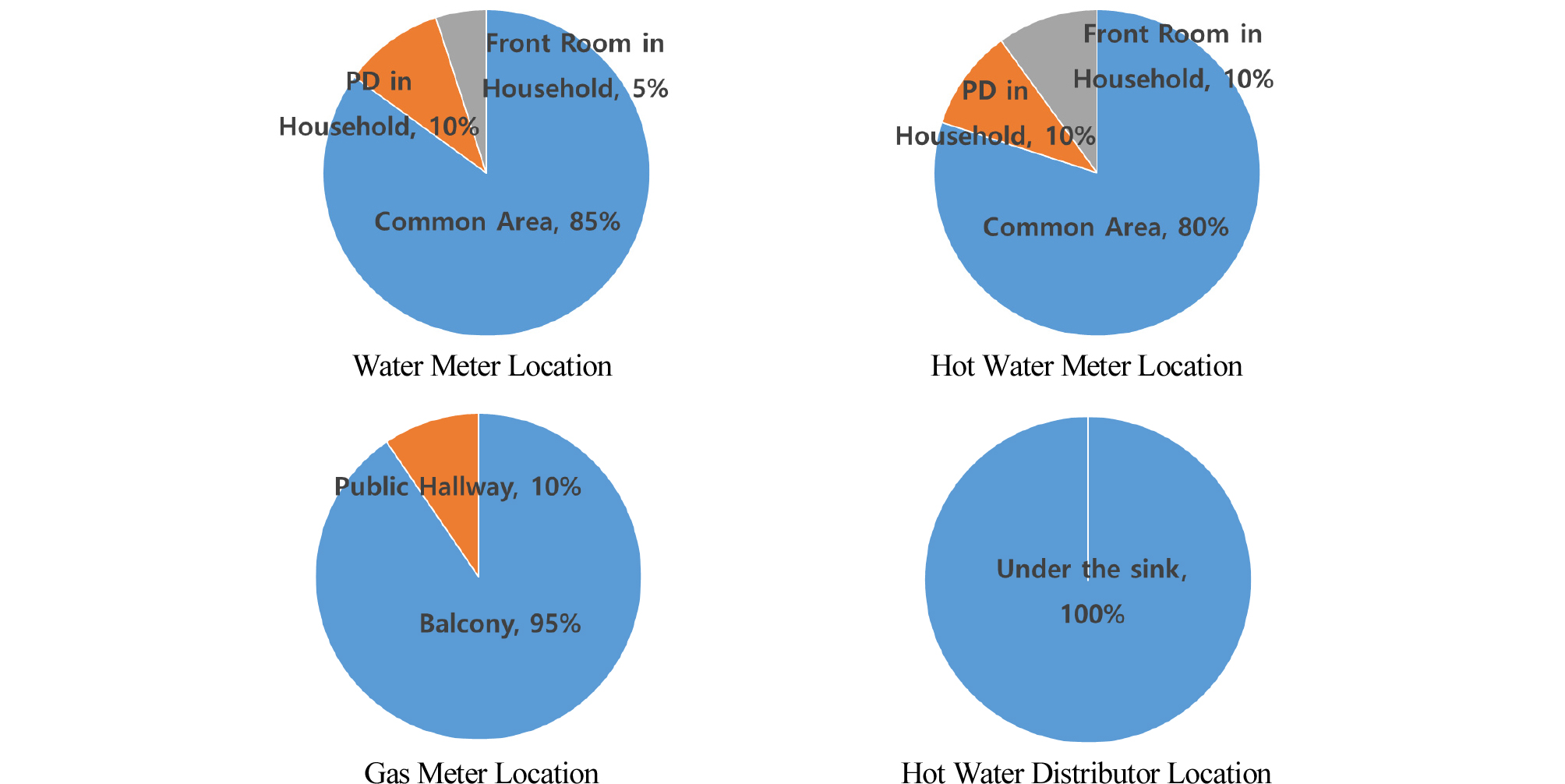
Figure 3.
Locational characteristics of each metering system
공동주택 20개 도면의 주요 조사결과는 다음과 같다. 첫째, 수도계량기는 85%가 공용부 PD에 설치하는 것으로 계획되었다. 10%는 세대 내 PD, 5%는 세대 내 현관입구(신발장 하부)에 설치한 사례도 있었다. 둘째, 지역열원을 사용하는 공동주택 10개소 기준으로 난방계량기의 위치는 공용부 PD 5개소, 세대 온수분배기 전단 및 후단(주방싱크대 하부)이 5개소로 조사되었다. 관련법 개정을 통하여 설치위치의 변화를 살펴볼 수 있는데, ‘중앙 집중 난방방식의 공동주택에 대한 난방계량기 등의 설치기준’에 의하면 2012년 개정 전까지 제6조 제5항에 따라 주로 주방싱크대 하단 온수분배기의 환수 측에 설치되었다. 그러나 2012년 개정된 동일고시 제2조 제5항에 의하면 난방계량기의 유지보수가 용이하도록 세대 전용부분 밖에 설치하도록 하고 있어, 현재는 주로 공용부 PD 부분에 설치하고 있는 것을 알 수 있다. 셋째, 가스계량기는 발코니 및 다용도실과 같이 옥외 입상에서 세대 내부로 가스 주관이 인입되어 설치된 경우가 95%였으며 이 때 가스계량기도 함께 발코니에 설치되었다. 공용부 복도에 설치된 사례는 5%(1개소)로 가스 주관이 공용부 복도로 계획되어 주방으로 인입된 사례였다. 넷째, 온수분배기는 모든 사례에서 주방 싱크대 하부에 배치된 것으로 나타났다. 이유는 단열 및 배수가 원활하고, 거주자의 편리한 조작 및 난방효율 등을 고려해야하기 때문인 것으로 조사되었다.
설비유닛을 통합한 해외사례 조사
국내 공동주택의 수도계량기, 난방계량기, 가스계량기, 전력량계, 온수 분배기 등 설비계량시스템의 통합 개발 방향을 설정하기 위하여 해외의 유사사례를 선정하여 살펴보았다. 조사대상의 선정기준은 지역난방의 에너지를 세대에 공급받는 방식 및 설비유닛의 통합 유무에 따라 2가지 사례를 선정하여 간접 및 직접공급방식으로 구분하여 조사하였다(Table 4 및 Figure 4 참조).
Table 4.
Overseas case study
|
Category
|
System overview
|
Characteristics of supply method
|
|
A
|
Indirect supply method
|
⦁Hot water indirect heating method
⦁Capacity (19 kW for heating, 35 kW for hot water)
⦁Automatic temperature control (electronic)
⦁The piping and heat exchanger plate is made of stainless steel
|
⦁Maintain a constant hot water temperature
⦁Prevention of internal bacteria and scale (foreign material) by hydraulic control
|
|
Direct supply method
|
⦁Direct heating method
⦁Capacity (15 kW for heating, 55 kW for hot water)
⦁The piping and heat exchanger plate is made of stainless steel
|
⦁Minimized installation space (can be attached or embedded in the wall)
⦁Prevention of internal bacteria and scale (foreign material) by hydraulic control
⦁Bypass can be installed to supply hot water immediately
⦁Can check the usage of waterworks
|
|
B
|
Indirect supply method
|
⦁Automatic temperature control function
⦁Automatically stops when there is no heating flow
|
⦁Self-regulated by thermostat
⦁Flow rate control by measuring the hot water temperature in the heat exchanger
|
|
Direct supply method
|
⦁Controlled by temperature control valve
⦁Control of priority switch for heating and hot water supply
|
⦁Control using temperature control valve (with its own temperature sensor)
⦁Pressure and precision temperature control by using differential pressure valve
|
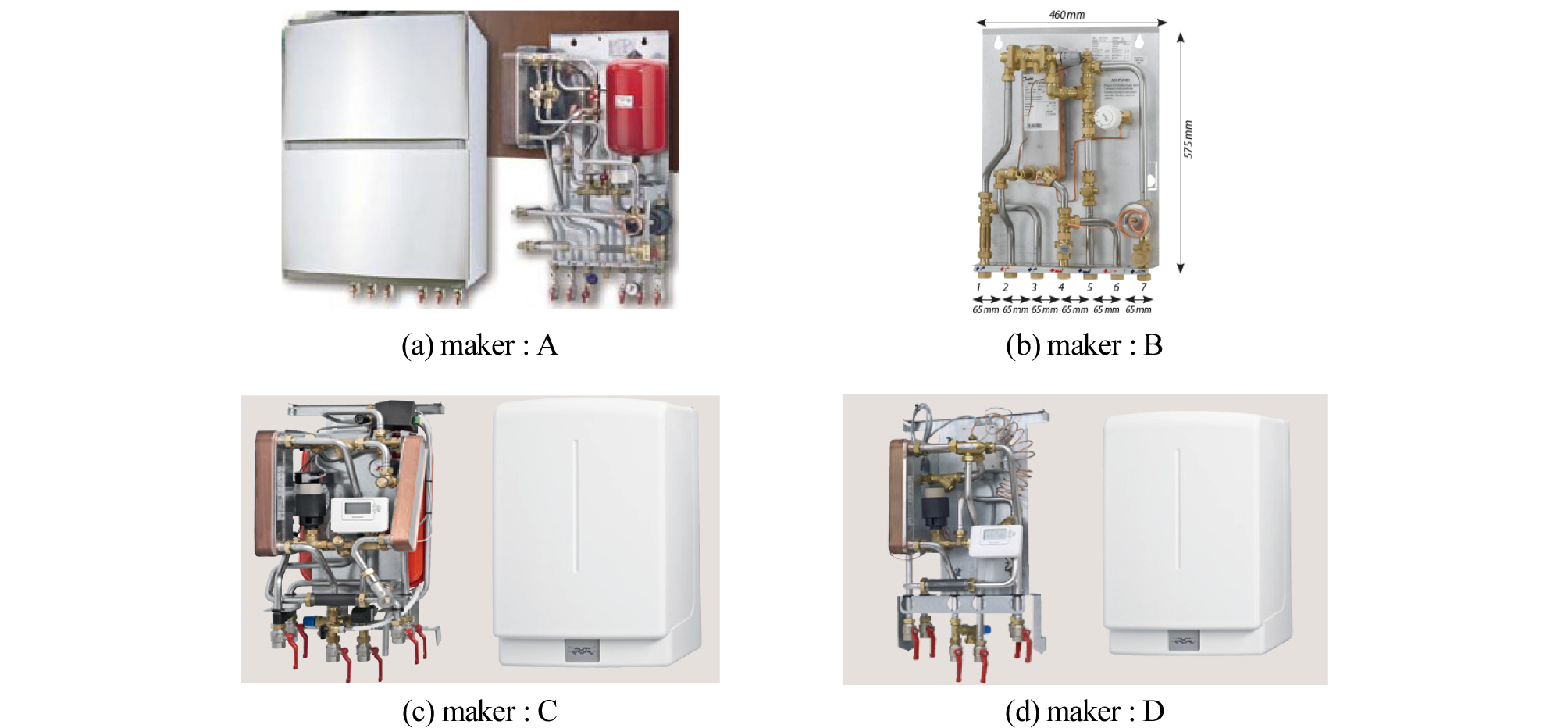
Figure 4.
Overseas facility measurement system example image
스마트 에너지 HIU 개발 방안 도출
본 연구에서 개발하고자 하는 스마트 에너지 HIU는 해외사례 조사 결과, 지역난방의 직접 열교환 방식에 사용되고 있는 것으로 나타났다. 본 시스템을 국내에 도입 하고자 하는 목적은 4세대 지역난방의 공급 및 이를 난방 및 급탕에너지로 세대 내 공급하는 역할때문이다. 이에 각 부문별 설비 계량 데이터를 통합하여 관리 플랫폼으로 전송하고 세대에서 손쉽게 확인 할 수 있도록 개발방향을 설정하기 위하여 각 설비 계량기별 관련 법규, 공동주택 설치 현황 사례, 해외 유사사례 조사를 실시하였다. 이를 토대로 개발 시 예상되는 문제점 및 이에 대한 개선방향, 설계 시 고려해야 할 사항을 도출하였다(Table 5 참조).
Table 5.
Development direction
|
Category
|
Problem
|
Improvement Direction
|
Design Considerations
|
|
Water
Meter
|
⦁Pipe length varies depending on the location of the hot water distributor, which can lead to increased heat loss
|
⦁When selecting the location of the hot water distributor, plan within the range that can minimize the pipe length and heat loss
|
⦁The hot water distributor of the household is placed in the common HIU, which has relatively little influence on the variation of household partition
⦁When installing the hot water distributor, it is installed on the floor to facilitate the connection of the landfill pipe
|
|
Heating
Meter
|
⦁Possible to increase management matters such as increase in piping volume for heating and hot water supply and increase in meter
|
⦁It is necessary to minimize hot water piping by applying a household-class hot water heat exchanger for each household
|
⦁Designed to use the indoor space as much as possible by placing it in the HIU due to the large volume of the household hot water heat exchanger
|
|
Gas
Meter
|
⦁When installing a gas meter balcony, it is difficult for the management to read or respond to the problem, and there is a problem of privacy infringement
|
⦁Improved for easy installation, inspection, and repair by installing it in the common unit HIU
|
⦁The gas meter is installed at least 1.6 m from the floor, and the distance from the electronic power meter is at least 0.6 m, and additional grills are installed for ventilation
|
|
Meter placement
|
⦁Various meters are distributed, limiting the integrated reading of management
|
⦁When all the meters are centrally placed in the HIU, the metering information and energy consumption can be monitored
|
⦁Keep a sufficient distance of more than 0.6 m from the gas meter and place it alongside the strategic meter to facilitate power supply
|
난방계획은 온수분배기의 위치에 따른 열손실을 최대한 줄이는 것이 관건으로, 세대 가변 시 비교적 영향이 적은 공용부 HIU에 배치하거나 최대한 매립배관과 연결이 용이한 바닥 하부에 설치하는 것이 바람직할 것이다. 또한 각 실에 균등한 유량공급을 위해 정유량 밸브와 온도조절밸브의 설치가 요구된다. 이때 리버스리턴(Reverse-returen) 등의 배관방식 적용이 가능하다. 급탕계획은 세대급탕열교환기의 부피가 크므로 HIU에 배치 시 실내공간을 최대한 활용할 수 있다는 장점이 있다. 가스계획 역시 가스계량기의 점검 및 보수가 용이하다는 측면이 있으며, HIU 설치 시 충분한 환기 및 안전이 고려되어야 한다. 각종 계량기의 배치 위치는 규격에 따라 적정한 이격거리를 유지하고 원할한 전원공급을 위해 전력량계와 나란히 배치하여 설계하는 것이 바람직하다.
결론 및 제언
최근 스마트, 모듈러, 장수명 주택 등 다양한 개념의 주택모델이 제시되고 있으며, 이에 맞춰 주택 설비 시스템도 더욱 효율적인 방향으로 개선이 요구된다. 스마트 에너지 HIU (Heat Interface Uint)는 4세대 지역난방 개념의 저온(60°C 이하) 의 온수를 공급 받아 이를 난방 및 급탕 에너지로 교환하여 세대 내에 공급하고, 부문별 계량 데이터를 통합 관리하는 시스템이다. 본 연구에서는 현재 공동주택에서 사용되고 있는 설비 계량기 현황을 분석하여 HIU으로의 통합방향을 도출하였다. 기존 공동주택의 급수, 급탕, 난방 계량기는 대부분 공용 PD에 설치되어 있으며, 통상적으로 온수분배기는 주방 싱크대 하부, 가스계량기는 발코니 및 복도 등에 각각 설치되어 있는 경우가 대부분이었다. 이를 HIU로 통합한다면, 공용 PD 공간에 설치하는 것이 가장 적합할 것이며, 이를 위해서는 건축적으로 충분한 PD 공간의 확보가 전제되어야 한다. 규모 또는 유형별 HIU의 반영을 위하여 설계 시 건축, 구조, 설비 관계자들의 사전협의가 반드시 필요하다. 본 연구에서는 공동주택을 위주로 분석하였으며, 향후 단독주택 적용방안까지 확대하여 보다 다양한 주거환경에서의 설비 개선방향에 대한 심도 있는 고민이 필요할 것으로 사료된다. 이를 통하여 장기적으로는 양방향 스마트 HIU 기술을 다양한 에너지 데이터를 통합 및 수집하는 네트워크 인프라 구축에 활용하는 것이 중요하다. 이에 에너지 데이터를 가시화하여 이를 스마트시티로 확장하는 후속 연구가 필요할 것으로 사료된다.
Acknowledgements
본 연구는 산업통상자원부(MOTIE)와 한국에너지기술평가원(KETEP)의 지원을 받아 수행한 연구 과제입니다(No. 2018201060010C).
References
Sung, S.K. (2008). A Flow Quality Distribution Characteristics of the Hot Water Header for Indivisual Room Control System. International Journal of Air-Conditioning and Refrigeration, 20(3), 175-180.
An, S.K., Moon, S.H., Kim, H.K., Jung, C.H., Yeo, M.S. (2017). Temperature Maintenance Performance Analysis of Heat Interface Unit with Consumption Variation of Domestic Hot Water for Individual Apartment Housing with District Heating. The Society Of Air-Conditioning and Refrigerating Engineers of Korea 2017 Winter Conference Proceedings, 346-349.
Jung, K.S., Kim, Y.I., Park, D.S., Kim, S.M., Lim, J.W., Lee, K.B. (2011). A Study on the Integrated Piping System for Secondary Heating Domestic Hot Water Desiccant Cooling in Apartment Housing. Korean Society for Energy 2011 Spring Conference Proceedings, 328.
Kim, Y.K., Kim, W.U., Eum, J.Y. (2019). Review of the heating supply method for 4
th generation district heating. Fall Conference of the Korean Society for New and Renewable Energy, 59.
Heo, H.J. (2012). A Study on the Optional Flow Distribution of the Hot Water Distributing System for Radiant Floor Heating System in Apartments. Master's Thesis. HanYang University, Republic of Korea.
Lee, J.Y. (2008). Developing a Flexible Heating/Sanitary System for Apartment Buildings. Master's Thesis. HanYang University, Republic of Korea.
Choi, I.S. (2019). Integrated piping system, contributes to effective use of district heating. Korea Heating Air-Conditioning Refrigeration & Renewable Energy News 'KHARN', 2019.7.7., https://www.kharn.kr/news/article.html?no=10136.
Kang, E.C. (2020). Smart energy AP unit development, Korea Heating Air-Conditioning Refrigeration & Renewable Energy News 'KHARN', 2020. 2.10., https://www.kharn.kr/ mobile/article.html?no=11897.
